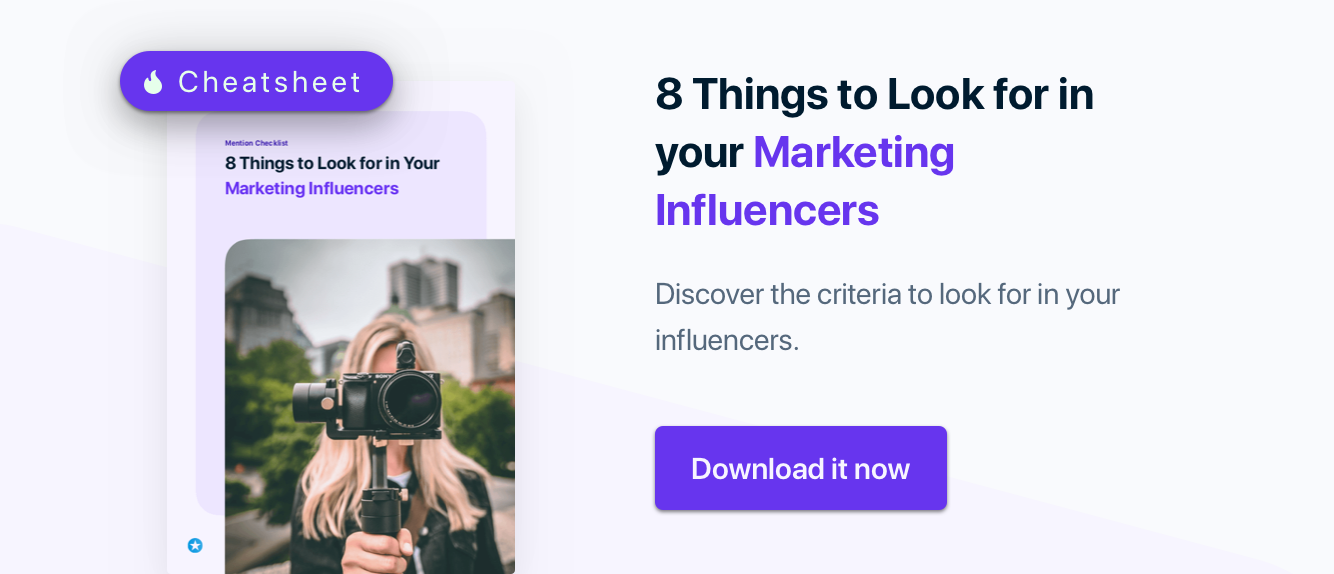Influencer marketing is about quality, not quantity.
You could have a campaign involving 50 influencers, each of them reaching millions of people every day – and see zero results from it.
Now that it’s become such a popular marketing tactic, sloppy or poorly targeted influencer campaigns won’t cut it anymore. You need to make sure you’re spending time building relationships that bring your team closer to meeting its goals.
You need to make sure your influencers are relevant to your campaign.
When you’re building the influencer strategy for your next round of marketing outreach, here’s what to look for in the pros you add to your outreach list:
Want to do target better influencers for your next campaign? Download our influencer research checklist to keep by your side.
1. Relevance
The very first thing to ask yourself is whether or not that person’s audience would even care about anything you’re doing.
You’re working with influencers in order to take advantage of their clout and audience. But if that clout and audience is in a field that has nothing to do with your brand, you won’t get much of an advantage.
An ideal influencer will talk about the topic you’re pitching already, or at least something very similar. For example, if I were creating an influencer list for an ebook about social media tools, I’d look for people who talk about that, or related topics like marketing tools, social media marketing, etc.

It’s also great if they’re talking to an audience similar to your own. You want to reach people who can convert – either by becoming a member of your community or by converting now.
So for that social media tools ebook, looking at any influencers who reach social media marketers will help grow my audience, even if they don’t specifically talk about the tools aspect of it all the time.
Influencer research tools that let you search for influencers by topic or area of expertise will help you identify who’s talking about your niche, or to your audience.
2. An engaged community
Some people have huge social media audiences full of people who don’t really care. A big reach doesn’t necessarily mean influence. You want to make sure a person’s followers, subscribers, etc. actually listen to what they’re saying and put some stock in the information.
If you’re looking to convert people or start conversations, it’s important that every influencer you work with has the ability to do so. They need to actually move people to action, whether that’s making a purchase, sharing something on Facebook, or visiting your website.
Look at the likes, shares, replies, comments, etc. they receive on social media and their website to see what kind of engagement they usually get. You also want to see what those reactions say – can you see if they’re they driving people to action?
Try to find evidence that they’ve actually influenced their audience. If they’ve done previous endorsements or partnerships, see what their audience’s reaction was.
3. Supports your campaign’s goals
A social media influencer may have limited benefits for a campaign focused on improving SEO rankings of a certain landing page. If they’re influence is only on social media and not other websites, there’s only so much they can do for that campaign.
But if you’re running a social campaigns where you want follows, comments, and shares, an influential website is only as good as its social media profiles. If the website is authoritative but their Twitter profile is dead and unengaged, save them for another campaign.
Make sure your campaign partners support your campaign goals. List out the different important KPIs, like:
- Backlinks
- Sales/conversions
- Email subscribers
- Social shares
- Traffic
Then you’ll want to tie each of those campaign metrics to an influencer metric. For example, the influencer metric for backlinks could be domain authority, and total reach would help predict social shares.
4. Previous collaborations
This isn’t a necessity, but it’s certainly helpful. If you can see that an influencer has worked with or promoted brands before, that’s one less hurdle to face in them saying ‘yes’ to your outreach pitch.
That means you only need to convince them to work with you, not the whole idea of promoting a brand like yours in the first place. You only need to sell your specific campaign’s value.
This also helps ensure that their audience won’t get turned off by a brand collaboration, unintentionally damaging your brand’s reputation.
5. They’re a good person
This has less to do with the marketing aspect and more to do with the fact that you’ll be in close contact with the influencers you work with. You don’t want to have to talk to jerks all the time!
Planning your campaign will be way easier when everyone can easily get along, respects each other, and no one acts like an asshole. If you’ve seen anything online to indicate that someone might be difficult to work with, or that you just won’t get along, think twice.
In some cases, the benefit an influencer can bring to your campaign might outweigh the cons of working with them. But when possible, save yourself the stress.
There’s more to influencers than influence
As with every marketing method, there’s way more involved than what’s on the surface. There’s more to influencers than just influencer. For your campaign, you want relevance, engagement, and to meet your goals without going crazy in the process.
Get more help with your influencer marketing:
Subscribe to Marketing + Monitoring Weekly
Get hot blog posts, insanely useful resources, and funny gifs every Friday.


